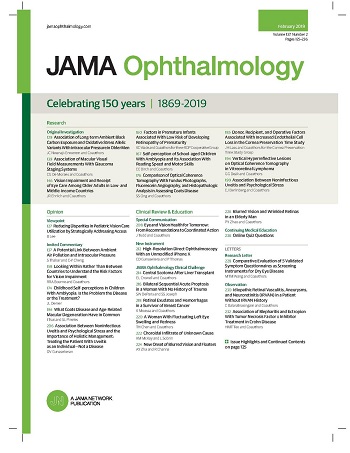玻璃体飞蚊症致视力退化性肌失视的功能问卷。
IF 9.2
1区 医学
Q1 OPHTHALMOLOGY
引用次数: 0
摘要
玻璃体飞蚊引起的视力退化性肌失视(VDM)可能与对比敏感度下降和视觉生活质量差有关,尽管目前尚不清楚如何最好地评估患者的主观障碍。特异性的、与视力相关的、患者报告的结果可能改善疾病严重程度的评估和治疗病例的选择,并为当前和未来的治疗提供有用的结果测量。目的编制玻璃体飞蚊功能问卷(VFFQ),探讨VFFQ评分与玻璃体密度的定量超声测量和对比灵敏度的视觉功能评价之间的相关性。设计、环境和参与者在一项单中心横断面研究中,对169名漂浮者进行了Rasch分析。在6个月以上的3个时间点对另外24名参与者进行了重测信度。在另一组224名参与者中进行了VFFQ评分与对比灵敏度和定量超声检查的相关性。数据分析时间为2017 - 2024年。参与者完成了自我管理的问卷,并接受了超声检查、对比敏感度测量和临床评估。主要结果和测量方法对比敏感度(Freiburg Acuity Contrast Test)、Cook距离、类内相关性、定量超声、Rasch分析、VFFQ综合评分。结果169名参与者(平均[SD]年龄57.5[14.4]岁,女性74 [43.8%]),Rasch分析剔除了8个问题,确定了23个符合VFFQ可接受标准的问题。24名参与者(平均[SD]年龄,56.0[13.5]岁;14名[58.3%]女性)3次完成23项VFFQ (VFFQ-23),其rasch校准的综合得分的类内相关性发现高的重测信度(0.850 [95% CI, 0.721至0.928];P < .001)。对224名参与者(平均[SD]年龄58.5[15.0]岁,99[44.2%]名女性)进行临床相关性评估。VFFQ-23评分与两组玻璃体超声密度有显著相关性(r = -0.752 [95% CI, -0.805 ~ -0.688]; P <。001)和对比敏感度(r = -0.744 [95% CI, -0.799至-0.677];P < .001)。结论与相关性VFFQ-23具有较高的重测信度,与玻璃体结构和视功能相关。这种与视力相关的玻璃体飞蚊症患者疾病严重程度的患者报告结果可能有助于个体患者评估、人群筛查和分诊,以及评估对当前治疗方法(如玻璃体切除术和YAG激光玻璃体溶解)和未来治疗方法(如纳米颗粒治疗和药理学玻璃体溶解)的反应。本文章由计算机程序翻译,如有差异,请以英文原文为准。
Vitreous Floaters Functional Questionnaire for Vision-Degrading Myodesopsia From Vitreous Floaters.
Importance
Vision-degrading myodesopsia (VDM) from vitreous floaters can be associated with degraded contrast sensitivity and poor visual quality of life, although it is unclear how to best evaluate subjective patient disturbances. Floater-specific, vision-related, patient-reported outcomes might improve assessment of disease severity and case selection for therapy as well as provide useful outcome measures of present and future treatments.
Objectives
To develop a Vitreous Floaters Functional Questionnaire (VFFQ) and to determine if the VFFQ score correlates with vitreous density measured by quantitative ultrasonography and with visual function evaluated by measuring contrast sensitivity.
Design, Setting, and Participants
In a single-center cross-sectional study, Rasch analysis was performed in 169 participants with floaters. Test-retest reliability at 3 time points over 6 months was performed in 24 other participants. Correlations of the VFFQ score with contrast sensitivity and quantitative ultrasonography were performed in a separate group of 224 participants. Data analysis was performed from 2017 to 2024.
Exposures
Participants completed the self-administered questionnaire and underwent ultrasonography, measures of contrast sensitivity, and clinical evaluation.
Main Outcomes and Measures
Contrast sensitivity (Freiburg Acuity Contrast Test), Cook distance, intraclass correlation, quantitative ultrasonography, Rasch analysis, and VFFQ composite score were measured.
Results
From 169 participants (mean [SD] age, 57.5 [14.4] years; 74 [43.8%] female), Rasch analysis eliminated 8 questions and identified 23 questions meeting acceptable criteria for the VFFQ. The intraclass correlation of Rasch-calibrated composite scores from 24 participants (mean [SD] age, 56.0 [13.5] years; 14 [58.3%] female) who completed the 23-item VFFQ (VFFQ-23) on 3 occasions found high test-retest reliability (0.850 [95% CI, 0.721 to 0.928]; P < .001). Clinical correlations were evaluated among 224 participants (mean [SD] age, 58.5 [15.0] years; 99 [44.2%] female). There were significant correlations between VFFQ-23 scores and both vitreous echodensity (r = -0.752 [95% CI, -0.805 to -0.688]; P < .001) and contrast sensitivity (r = -0.744 [95% CI, -0.799 to -0.677]; P < .001).
Conclusions and Relevance
The VFFQ-23 had high test-retest reliability and correlated with vitreous structure and visual function. This vision-related patient-reported outcome of disease severity in patients with vitreous floaters might be useful for individual patient evaluations, population screening and triage, and assessing the response to current therapies, like vitrectomy and YAG laser vitreolysis, and future therapies, such as nanoparticle treatments and pharmacologic vitreolysis.
求助全文
通过发布文献求助,成功后即可免费获取论文全文。
去求助
来源期刊

JAMA ophthalmology
OPHTHALMOLOGY-
CiteScore
13.20
自引率
3.70%
发文量
340
期刊介绍:
JAMA Ophthalmology, with a rich history of continuous publication since 1869, stands as a distinguished international, peer-reviewed journal dedicated to ophthalmology and visual science. In 2019, the journal proudly commemorated 150 years of uninterrupted service to the field. As a member of the esteemed JAMA Network, a consortium renowned for its peer-reviewed general medical and specialty publications, JAMA Ophthalmology upholds the highest standards of excellence in disseminating cutting-edge research and insights. Join us in celebrating our legacy and advancing the frontiers of ophthalmology and visual science.
 求助内容:
求助内容: 应助结果提醒方式:
应助结果提醒方式:


